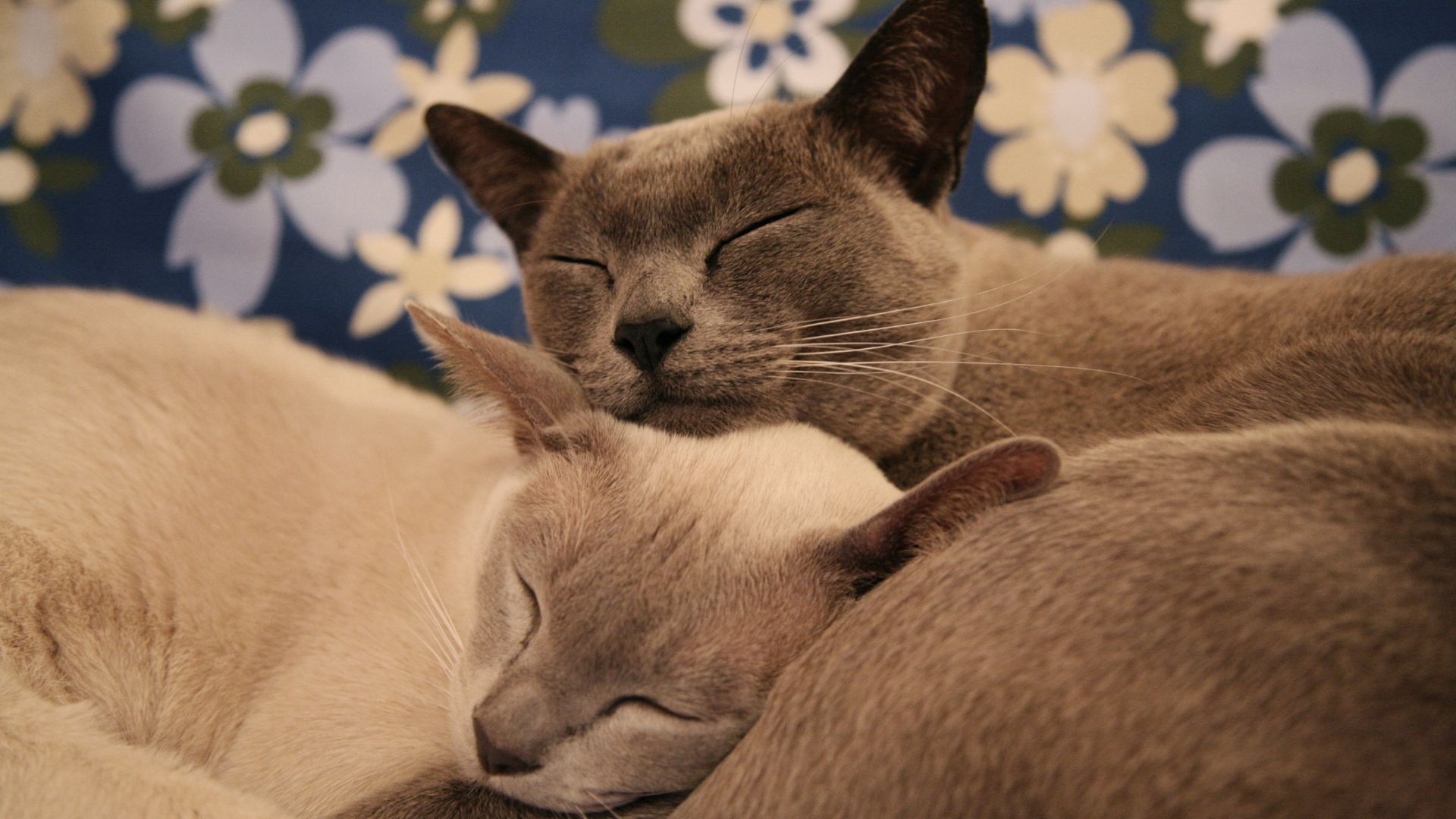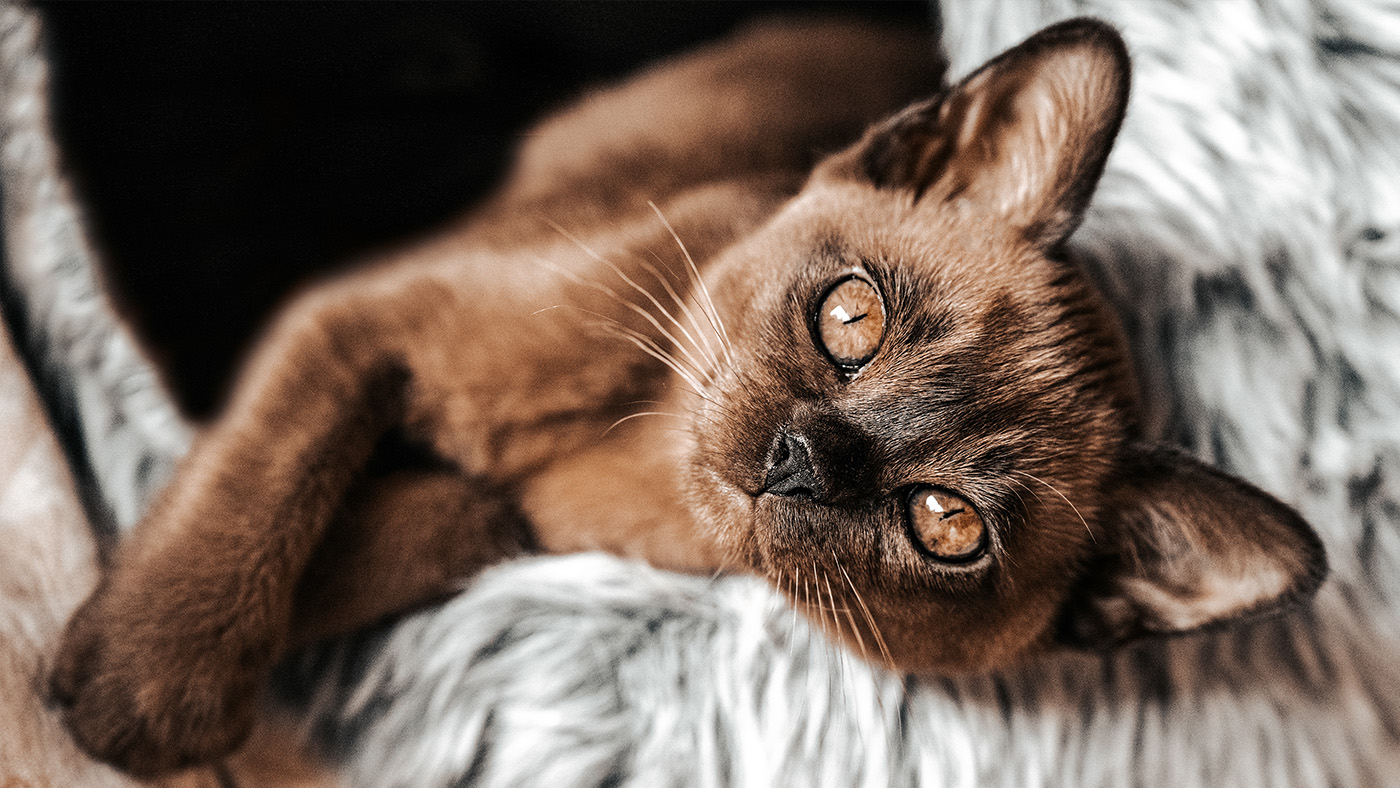The attention-loving Burmese cat is high on energy (and life!)
Wondering if a Burmese is right for your home?


Life expectancy: 15–20 years
Size: 10–12 inches (length), 15–18 inches (height), 6–14lbs (weight)
Coat: chocolate, blue, brown, grey and red, dilute divisions or two-tone variations
Eye colour: golden, yellow, or green
Temperament: social, inquisitive, and good with children
Origin/native country: Burma (Myanmar)
Originating from Burma, which is now known as Myanmar, the silky soft Burmese cat resulted from a cross between a female cat named Wong Mau and an American Siamese.
Dating back to the 1930s, most Burmese cats tend to be brown or chocolate brown in color (although you can find them in blue, red and two-tone variations) and despite the difference in their coloring, a Burmese is most often likened to a Bombay – and for good reason. Along with sharing dog-like tendencies, being very vocal and playful, just like a Bombay, a Burmese is also a very affectionate and attention-demanding family cat.
Of course, choosing a new furry family member is no mean feat. To help you understand this breed and find more information about their personality, traits and grooming needs, we spoke to vet Dr Rebecca MacMillian.
Are Burmese Cats hypoallergenic?
According to Dr MacMillan, Burmese cats are labelled as hypoallergenic because they are thought to produce lower levels of ‘Fel D1’ than other breeds of cats. This is the protein in a cat’s saliva and urine that triggers allergies in those susceptible to reactions.
“They also shed less hair than other breeds, meaning less of the protein gets into the environment,” Dr MacMillan adds. “However, this doesn’t mean that they don’t shed altogether, and sensitive allergy sufferers could still be affected.”
Therefore, if you are allergy-prone and thinking of adopting a Burmese, it’s well worth spending some time around this cat to see whether this breed triggers your allergies. For more information on hypoallergenic cat breeds for allergy sufferers, we’ve pulled together an expert-led guide. We’ve also compiled a list of the non-shedding cats.
If you’re unsure if you’re allergic to cats, these are the symptoms to look out for.
Get the best advice, tips and top tech for your beloved Pets
How long do Burmese cats live?
How long a cat lives for will depend on a variety of factors. For example, the breed and environment are just two components that will affect their lifespan.
That said, in general, the average life expectancy of a crossbreed cat is around 14 years. While purebred cats live shorter lives, with an average of 12.5 years.
Burmese cats are a crossbreed, and they are considered a healthy breed. Therefore, with the right care, they can live for anywhere between 15 to 20 years, which makes them one of the longest living cat breeds.
“Some may even go into their 20s,” explains Dr MacMillian.

Are Burmese cats friendly?
Yes! These lovable creatures are one of the friendliest cat breeds you’ll come across. Always up for a cuddle (or three!), Burmese cats are people purrr-sons who will want to spend as much time with their owners as possible.
“These cats are known for their friendly and affectionate natures,” confirms Dr MacMillan. “They are very sociable and can even be trained to do simple tricks,” the vet adds. “Their easy-going nature means that they often get along with other pets and children, provided they have had the right socialization and introductions.”
At first, figuring out how to socialize a kitten may feel daunting. But the process isn’t as complicated as it might seem. Plus, it will help your kitty master the skills and behaviors they need to thrive.
How much grooming does a Burmese cat need?
These short-haired cats have sleek coats that are relatively easy to care for.
“Brushing them once a week should be enough to keep their coat in order,” Dr MacMillan says.
How much exercise does a Burmese cat need?
A Burmese kitty is classed as a high-energy breed that will want to play with you all the time. So you’ll want to learn how to play with a cat if you’re adopting this breed, as they will thrive off playing with their humans.
Exercise-wise, a Burmese cat will need at least 30 minutes of exercise per day, which can be broken down into shorter play sessions.
“These cats are quite energetic and playful,” explains Dr MacMillan. “So make sure to provide them with plenty of toys and climbing options.”
For example, the best cat toys are real boredom busters and will keep your Burmese mentally stimulated and physically fit. While the best automated cat toys will give your kitty something to play with even if you’re not around.
And for cats who love to climb – like the Burmese – the best cat trees will help your kitty survey the world up high.
Wisdom Panel Cat DNA Test | Amazon
Not sure exactly what breed your cat is? This kit screens for 70+ breeds, 45 genetic health insights and 25+ physical traits – because knowing every detail about your cat helps you understand how best to care for them.
Burmese cat health problems
Despite a Burmese cat having a long lifespan, Dr MacMillan says that this breed is susceptible to diabetes.
To prevent this from happening, Dr MacMillan advises: “Maintaining a healthy body weight and encouraging physical activity will help to reduce the risk of their Burmese developing this problem.”
It’s also worth watching out for the signs of diabetes in cats, which include increased thirst, increased urination, weight loss, and muscle weakness.
“If an owner notices these signs, then they should take their cat to be checked over by a vet as soon as possible,” the vet adds.
Calcium oxalate bladder stones are another health problem that can occur in some Burmese cats, which could require surgery and a change of diet to resolve.
“To help prevent bladder stones, owners should encourage increased water intake by feeding a wet diet, adding water to their existing food, providing plenty of water bowls, or considering the use of a cat drinking fountain,” the veterinarian adds.

How much does a Burmese cat cost?
How much you pay out for a Burmese will depend on a few things. For example, the state you’re in and the breeder you choose will all hinge on how much your kitty will cost.
But generally speaking, an average Burmese cat can cost anywhere between $600–1,000, which makes them a relatively affordable kitty that's similar in price to a Burmilla and Cornish Rex cat, but much cheaper than a Bombay.
Should I get a Burmese cat?
This depends on a few things. For starters, Burmese cats are highly sociable creatures who thrive when they’re in human company. So they wouldn’t like being left alone for long periods of time – Burmese cats are best suited to owners who are around a lot.
“A family or owner that could spend plenty of time playing and training their cat would be ideal,” highlights Dr MacMillan. “Because these cats thrive on companionship, some can develop separation anxiety when they do have to be left on their own.”
Of course, no cat owner would be expected to wait hand and foot on their feline for 24 hours a day. So if you are prone to nipping in and out of the house, puzzle feeders and toys are a great way to keep these cats busy while you are gone.
According to Dr MacMillan, a Burmese cat could also be suitable for homes that are wishing for two fur friends.
“Potential owners could also consider adopting two kittens that grow up together,” the vet adds.
This guide covers caring for Burmese cats, including what to consider before buying, daily care, personality, health, temperament, diet, clubs, breeders, the equipment you need, along with your responsibilities as an owner.
Read next: Reasons to love Burmese cats

Having graduated in 2009 from the Royal Veterinary College in London as a veterinary surgeon, Rebecca is highly experienced in first opinion small animal practice, having done a mixture of day-to-day routine work, on-call emergency duties and managerial roles over the years. Rebecca recently achieved a BSAVA postgraduate certificate in small animal medicine (with commendation).
Rebecca writes on various feline and canine topics, including behavior, nutrition, and health. Outside of work and writing she enjoys walking her own dog, spending time with her young family and baking!
Edited by Georgia Guerin.
This feature was last updated in August 2025 by Becks Shepherd.

Becks Shepherd is a lifestyle journalist who has worked with titles such as Tom's Guide, Marie Claire, and Fit and Well.
In addition to this, she’s a pet writer with nearly a decade of editorial experience across digital and print media. A devoted “dog aunt” and lifelong animal lover, Becks brings a personal touch to her pet content—whether she’s testing the latest dog gear or digging into behavioral tips.
She works closely with veterinary experts to ensure factual accuracy and is currently exploring animal care certifications to deepen her knowledge. Her work has appeared in leading outlets across health, wellness, and pet care spaces.


